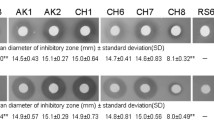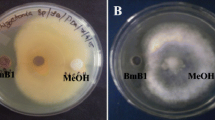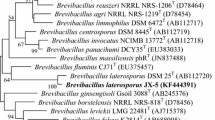Abstract
B. amyloliquefaciens D2WM, a plant growth-promoting rhizobacteria from the Camellia oleifera rhizosphere, exhibits strong antimicrobial activity and has the capacity to promote plant growth, and this study aimed to determine its antibacterial mechanism against the soft rot disease pathogen D. chrysanthemi HBEU-9. The metabolites from D2WM were also identified and purified. The crude extract (CE) of D2WM effectively inhibited the mycelial growth of five fungal species and the growth of five bacterial species. In particular, CE was well able to inhibit walnut blight caused by Xanthomonas arboricola pv. Juglandis, which is an effect that has rarely been reported. Compared with the control, the addition of 0.2%–0.3% CE to the growth medium notably decreased the cell biomass of HBEU-9 and significantly increased the membrane permeability, soluble proteins and reducing sugars of HBEU-9. SEM and TEM analyses revealed that CE could destroy the cell wall and distort cells and decreased the levels of cell-degrading enzymes (Cx, PG and PMG) by 23.4%, 53.8% and 27.5%, respectively. Importantly, CE retained nearly 80% activity after either storage for 7 months at 4 °C or exposure to 121 °C for 30 min. In addition, the most essential antibacterial compound, macrolactin A, was purified and identified from D2WM cultures through column chromatography, semi-preparative HPLC and HPLC-MS. Taken together, our results highlight the potential of B. amyloliquefaciens D2WM as a biocontrol agent against bacterial diseases and the utility of macrolactin A as an antimicrobial compound.




Similar content being viewed by others
References
Arguelles Arias, A., Ongena, M., Devreese, B., Terrak, M., Joris, B., & Fickers, P. (2013). Characterization of amylolysin, a novel lantibiotic from Bacillus amyloliquefaciens GA1. PLOS, 8, 83–37.
Bandara, Y., Weerasooriya, D., Liu, S., & Little, C. (2018). The vecrotrophic fungus Macrophomina phaseolina promotes charcoal rot susceptibility in grain sorghum through induced host cell-wall-degrading enzymes. PHYTOPATHOLOGY, 108, 948–956.
Baz, M., Lahbabi, D., Samri, S., Val, F., Hamelin, G., Madore, I., Bouarab, K., Beaulieu, C., & Ennaji, M. M. (2012). Barakate, M. control of potato soft rot caused by Pectobacterium carotovorum and Pectobacterium atrosepticum by moroccan actinobacteria isolates. World Jornal of Microbiology and Biotechnology, 28, 303–311.
Bradford, M. (1976). A rapid and sensitive method for the quantitation quantities microgram principle of protein-dye binding. Analytical Biochemistry, 72, 248–254.
Byrne, J. M., Dianese, A. C., Ji, P., Campbell, H. L., Cuppels, D. A., Louws, F. J., Miller, S. A., Jones, J. B., & Wilson, M. (2005). Biological control of bacterial spot of tomato under field conditions at several locations in North America. Biological Control, 32, 408–418.
Chapman and Hall (2003). The combined chemical dictionary on CD-ROM v 6.1. Head FAST CD software.
Chen, X. H., Koumoutsi, A., Scholz, R., Eisenreich, A., Schneider, K., Heinemeyer, I., Morgenstern, B., Voss, B., Hess, W. R., Reva, O., Junge, H., Voigt, B., Jungblut, P. R., Vater, J., Süssmuth, R., Liesegang, H., Strittmatter, A., Gottschalk, G., & Borriss, R. (2007). Comparative analysis of the complete genome sequence of the plant growth-promoting bacterium Bacillus amyloliquefaciens FZB42. Nature Biotechnology, 25, 1007–1014.
Chen, X. H., Scholz, R., Borriss, M., Junge, H., Mögel, G., Kunz, S., & Borriss, R. (2009). Difficidin and bacilysin produced by plant-associated Bacillus amyloliquefaciens are efficient in controlling fire blight disease. Journal of Biotechnology, 140, 38–44.
Chowdhury, S. P., Hartmann, A., Gao, X. W., & Borriss, R. (2015). Biocontrol mechanism by root-associated Bacillus amyloliquefaciens FZB42–a review[J]. Frontiers in Microbiology, 6, 780.
Gardan, L., Gouy, C., Christen, R., & Samson, R. (2003). Elevation of three subspecies of Pectobacterium carotovorum to species level: Pectobacterium atrosepticum sp. nov., Pectobacterium betavasculorum sp. nov. and Pectobacterium wasabiae sp. nov. International Journal of Systematic and Evolutionary Microbiology, 53, 381–391.
Gu, Q., Yang, Y., Yuan, Q., Shi, G., Wu, L., Lou, Z., Huo, R., Wu, H., Borriss, R., & Gao, X. (2017). Bacillomycin D produced by Bacillus amyloliquefaciens is involved in the antagonistic interaction with the plant-pathogenic fungus Fusarium graminearum. Applied and Environmental Microbiology, 83.
Gustafson, K., Roman, M., & Fenical, W. (1989). The macrolactins, a novel class of antiviral and cytotoxic macrolides from a deep-sea marine bacterium. Journal of the American Chemical Society, 111, 7519–7524.
He, P., Hao, K., Blom, J., Rückert, C., Vater, J., Mao, Z., Wu, Y., Hou, M., He, P., He, Y., & Borriss, R. (2012). Genome sequence of the plant growth promoting strain Bacillus amyloliquefaciens subsp. plantarum B9601-Y2 and expression of mersacidin and other secondary metabolites. Journal of Biotechnology, 164, 281–291.
Horsfall, J. G., & Cowling, E. B. (1980). Plant disease-an advanced treatise (Vol. 5, pp. 351–359). New York: Academic Press.
Jasim, B., Sreelakshmi, K. S., Mathew, J., & Radhakrishnan, E. K. (2016). Surfactin, iturin, and fengycin biosynthesis by endophytic Bacillus sp. from Bacopa monnieri. Microbial Ecology, 72, 106–119.
Ji, P., Campbell, H. L., Kloepper, J. W., Jones, J. B., Suslow, T. V., & Wilson, M. (2006). Integrated biological control of bacterial speck and spot of tomato under field conditions using foliar biological control agents and plant growth-promoting rhizobacteria. Biological Control, 36, 358–367.
Jia, Y. J., Feng, B. Z., Sun, W. X., & Zhang, X. G. (2009). Polygalacturonase, pectate lyase and pectin methylesterase activity in pathogenic strains of Phytophthora capsici incubated under different conditions. Journal of Phytopathology, 157, 585–591.
Kim, Y. G., Kang, H. K., Kwon, K., Seo, C. H., Lee, H. B., & Park, Y. (2015). Antagonistic activities of novel peptides from Bacillus amyloliquefaciens PT14 against Fusarium solani and Fusarium oxysporum. Journal of Agricultural and Food Chemistry, 63, 10380–10387.
Lim, J. A., Jee, S., Lee, D. H., & Roh, E. (2013). Biocontrol of Pectobacterium carotovorum subsp. carotovorum using bacteriophage PP1. Journal of Microbiology and Biotechnology, 23, 1147–1153.
Liu, C., Sheng, J., Chen, L., Zheng, Y., Lee, D. Y. W., Yang, Y., Xu, M., & Shen, L. (2015). Biocontrol activity of Bacillus subtilis isolated from Agaricus bisporus mushroom compost against pathogenic fungi. Journal of Agricultural and Food Chemistry, 63, 6009–6018.
Madigan, M., & Martinko, J. (2009). Brock biology of microorganisms (pp. 95–113). Beijing: Science press.
Maria, D. P. M., Weber, B., Witherell, R. A., Willis, D., & Charkowski, A. (2011). The 3-Hydroxy-2-butanone pathway is required for Pectobacterium carotovorum pathogenesis. PLoS One, 6, e22974.
Rajeswari, P., & Kapoor, R. (2017). Combinatorial efficacy of Trichoderma spp. and Pseudomonas fluorescens to enhance suppression of cell wall degrading enzymes produced by fusarium wilt of Arachis hypogaea. L. International Journal of Agricultural Research, Innovation and Technology, 7, 36–42.
Ravensdale, M., Blom, T. J., Gracia-Garza, J. A., Svircev, A. M., & Smith, R. J. (2007). Bacteriophages and the control of Erwinia carotovora subsp. carotovora. Canadian Journal of Plant Pathology, 29, 121–130.
Roh, E., Park, T. H., Kim, M. I., Lee, S., Ryu, S., Oh, C. S., Rhee, S., Kim, D. H., Park, B. S., & Heu, S. (2010). Characterization of a new bacteriocin, carocin D, from Pectobacterium carotovorum subsp. carotovorum Pcc21. Applied and Environmental Microbiology, 76, 7541–7549.
Shakeel, M., Rais, A., & Hassan, M. N. (2015). Hafeez FY. Root associated Bacillus sp. improves growth, yield and zinc translocation for basmati rice (Oryza sativa) varieties. Frontiers in Microbiology, 6, 1286.
Sista Kameshwar, A. K., & Qin, W. (2018). Structural and functional properties of pectin and lignin–carbohydrate complexes de-esterases: A review. Bioresources and Bioprocessing, 5, 43.
Tan, C. D., Zhu, M. J., Du, S. X., & Yao, Y. F. (2016). Study on the inhibition zone method in antimicrobial test. Food Industry, 37, 122–125.
Toscano, P. L., Montero, A. G., Stilianova, S. M., Vertiz, P. E., & Uscanga, Y. E. R. (2015). Cellulase production from filamentous fungi for its application in the hydrolysis of wheat straw. In MRS online proceeding library archive (Vol. 1763, pp. 369–377).
Wang, L. (2010). Study on the mechanism of fungicides inhibiting to the importants pathogens in Polygonum multiflorum. China, Guizhou University (pp. 52–53). Master Degree Dissertation.
Wei, M., Zhu, J. Q., Guan, W. X., Zhang, W., Fu, B. Z., Wang, L. H., Li, G. Y., & Jin, W. (2017). First report of Fusarium avenaceum causing root rot of Maca (Lepidium meyenii) in China. Plant Disease, 101, 832.
Wei, M., Chen, J. M., Fu, B. Z., Li, G. Y., & Wang, X. S. (2018). First report of brown leaf blight of Shenguyou (Staphylea bumalda) caused by Alternaria alternate in China. Plant Disease, 102, 2034.
Wu, L., Wu, H., Chen, L., Yu, X., Borriss, R., & Gao, X. (2015). Difficidin and bacilysin from Bacillus amyloliquefaciens FZB42 have antibacterial activity against Xanthomonas oryzae rice pathogens. Science Reports, 5, 12975.
Xue, C. Y., Zhou, R. J., Li, Y. J., Xiao, D., & Fu, J. F. (2018). Cell-wall-degrading enzymes produced in vitro and in vivo by Rhizoctonia solani, the causative fungus of peanut sheath blight. PEER J, 6, e5580.
Yu, D. Y., Yao, T. A., Huang, P., & Chen, L. J. (2013). Effects of bacterial shot-hole stress on proteins and amino acids contents in leaves of plum trees. Journal of Plant Protection, 5, 035.
Yuan, J., Raza, W., Shen, Q., & Huang, Q. (2012). Antifungal activity of Bacillus amyloliquefaciens NJN-6 volatile compounds against Fusarium oxysporum f. sp. cubense. Applied and Environmental Microbiology, 78, 5942–5944.
Acknowledgements
This work was supported by funds from the National Natural Science Foundation of China (No. 31600055 and 31671980), Outstanding Youth Fund of Jiangsu Province (BK20160016). In addition, we would like to thank Pei Zhang, Du An-na and Bichao Xu from The Core Facility and Technical Support, Wuhan Institute of Virology, for their help with producing the TEM and SEM micrographs.
Author information
Authors and Affiliations
Corresponding author
Ethics declarations
The authors bear all the ethical responsibilities associated with this manuscript. They declare that the research was conducted in the absence of any commercial or financial relationships that could be construed as a potential conflict of interest and that it does not include any animal and/or human trials.
Rights and permissions
About this article
Cite this article
Chen, J., Liu, T., Wei, M. et al. Macrolactin a is the key antibacterial substance of Bacillus amyloliquefaciens D2WM against the pathogen Dickeya chrysanthemi. Eur J Plant Pathol 155, 393–404 (2019). https://doi.org/10.1007/s10658-019-01774-3
Accepted:
Published:
Issue Date:
DOI: https://doi.org/10.1007/s10658-019-01774-3




